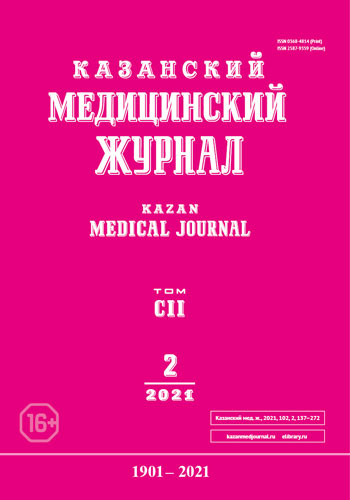Система глутатиона в костной ткани при действии компонентов медно-цинковой руды и введении антиоксидантов
- Авторы: Курамшина Г.Р.1, Камилов Ф.Х.1
-
Учреждения:
- Башкирский государственный медицинский университет
- Выпуск: Том 102, № 2 (2021)
- Страницы: 199-205
- Раздел: Экспериментальная медицина
- Статья получена: 06.01.2021
- Статья одобрена: 02.03.2021
- Статья опубликована: 06.04.2021
- URL: https://kazanmedjournal.ru/kazanmedj/article/view/57563
- DOI: https://doi.org/10.17816/KMJ2021-199
- ID: 57563
Цитировать
Аннотация
Цель. Изучение изменений в системе глутатиона костной ткани при хронической интоксикации элементами, содержащимися в медно-цинковой колчеданной руде, и введении антиоксидантного витаминного препарата.
Методы. Эксперименты проведены на 36 половозрелых самцах белых крыс, разделённых на три группы (контрольную, сравнения, опытную). Интоксикацию крыс опытной группы и группы сравнения вызывали внутрижелудочным введением в течение 3 мес ежедневно суспензии порошка медно-цинковой колчеданной руды в 2% растворе крахмала из расчёта 60 мг/100 г массы тела. Опытная группа в течение последнего месяца получала антиоксидантный витаминный препарат (комплекс витаминов с микроэлементом), содержащий α-токоферол, β-каротин, аскорбиновую кислоту и селен. В гомогенатах эпифизов бедренных костей определяли содержание восстановленного глутатиона, свободных тиоловых групп белков, активность глутатионпероксидазы, глутатионтрансферазы, глутатионредуктазы, γ-глутамилтрансферазы, глюкозо-6-фосфатдегидрогеназы. Математическую обработку результатов осуществляли с помощью программы Statistica 6.0, определяли медиану (Ме) и процентили (Q1 и Q2), различия межгрупповых величин оценивали по U-критерию Манна–Уитни.
Результаты. Хроническая интоксикация элементами, содержащимися в медно-цинковой колчеданной руде, вызывает в костной ткани нарушения функционирования системы глутатиона. У экспериментальных животных по сравнению с контролем происходят снижение содержания восстановленного глутатиона до 71,9% (р=0,014) и свободных сульфгидрильных групп белков до 77,8% (р=0,0143), ингибирование активности глутатион-зависимых антиоксидантных ферментов, нарушения системы восстановления глутатиона в тканях. Введение антиоксидантного витаминного препарата повышает уровень восстановленного глутатиона и свободных тиоловых групп белков, активирует ферменты глутатионовой системы: содержание восстановленного глутатиона повышается до 94,8% (р=0,2132), активность глутатионпероксидазы — до 85,7% (р=0,0432), глутатионтрансферазы — до 94,3% (р=0,5251), глутатионредуктазы — до 86,1% (р=0,0442) по сравнению с показателями контрольной группы животных.
Вывод. Хроническая интоксикация металлами, содержащимися в медно-цинковой колчеданной руде, приводит к уменьшению содержания восстановленного глутатиона и свободных тиоловых групп белков в костях на фоне снижения активности глутатионредуктазы и глюкозо-6-фосфатдегидрогеназы, торможению активности глутатионпероксидазы и глутатионтрансферазы; введение антиоксидантного витаминного препарата способствует повышению в костной ткани активности ферментов восстановления глутатиона, содержания восстановленного глутатиона и свободных сульфгидрильных групп белков, активности глутатионпероксидазы и глутатионтрансферазы.
Полный текст
Об авторах
Гульназ Ришатовна Курамшина
Башкирский государственный медицинский университет
Автор, ответственный за переписку.
Email: tabletkadg@yandex.ru
Россия, г. Уфа, Россия
Феликс Хусаинович Камилов
Башкирский государственный медицинский университет
Email: tabletkadg@yandex.ru
Россия, г. Уфа, Россия
Список литературы
- Кулинский В.И., Колесниченко Л.С. Система глутатиона. I. Синтез, транспорт глутатионтрансферазы, глутатионпероксидазы. Биомед. химия. 2009; 55 (3): 255–277.
- Aquilano K., Baldelli S., Ciriolo M.K. Glutatione: new roles in redox signaling for an old antioxidant. Front. Pharmacol. 2014; 5: 196. doi: 10.3389/f.phor.2014.00196.
- Меньщикова Е.Б., Ланкин В.З., Зенков Н.К., Бондарь И.А., Круговых Н.Ф., Труфакин В.А. Окислительный стресс. Прооксиданты и антиоксиданты. М.: Слово. 2006; 556 c.
- Токсикологическая химия. Метаболизм и анализ токсикантов. Под ред. Н.И. Калетиной. М.: ГЭОТАР-Медиа. 2008; 1016 с.
- Аглетдинов Э.Ф., Нургалеев Н.В., Фаршатова Е.Р., Таирова Э.И. Влияние полиметаллической пыли медно-цинковых колчеданных руд на состояние минерального обмена и костной ткани. Вестн. Оренбургского гос. ун-та. 2011; (15): 15–18.
- Трофимчук А.А., Кабирова М.Ф., Гуляева О.А., Каримова Л.К., Саляхова Г.А Оценка риска развития заболеваний полости рта у работников горно-обогатительного комбината, занятых добычей и переработкой медно-цинковых руд. Уральский мед. ж. 2018; (4): 52–54. doi: 10.25694/URMJ.2018.04.039.
- Каримова Л.К., Серебряков П.В., Шайхлисламова Э.Р., Яцына И.В. Профессиональные риски нарушения здоровья работников, занятых добычей и переработкой полиметаллических руд. Под ред. В.Н. Ракитского, А.Б. Бакирова. М.: Уфа. 2016; 337 с.
- Камилов Ф.Х., Фаршатова Е.Р., Меньшикова И.А., Бикметова Э.Р., Ганеев Т.И. Остеопороз: влияние химических факторов производственной среды на метаболизм костной ткани. Уфа: ГУП РБ Уфимский полиграфкомбинат. Мир печати. 2015; 311 с.
- Фаршатова Е.Р., Меньшикова И.А., Камилов Ф.Х. Влияние металлов, содержащихся в медно-цинковых колчеданных рудах, на метаболизм костной ткани. Мед. вестн. Башкортостана. 2014; 9 (4): 57–59.
- Фаршатова Е.Р., Ганеев Т.И., Меньшикова И.А., Сарменеева Л.В., Нургалеев Н.В., Камилов Ф.Х. Влияние элементов медно-цинковых колчеданных руд на ремоделирование костной ткани и факторы его регуляции. Казанский мед. ж. 2015; 96 (5): 783–787. doi: 10.17750/KMJ2015-783.
- Давлетгареева Г.Р., Фаршатова Е.Р. Характеристика системы глутатиона в костной ткани при длительном поступлении элементов медно-цинковых колчеданных руд. Наука молодых (Eruditio Juvenium). 2017; 5 (2): 165–174. doi: 10.23888/HMJ20172165-174.
- Борисенок О.А., Бушма М.И., Басалай О.Н., Радковец А.Ю. Биологическая роль глутатиона. Мед. новости. 2019; 7 (298): 3–8.
- Prigge J.R., Coppo L., Martin S.S., Ogata F., Miller C.G., Bruschwein M.D., Orlicky D.J., Shearn C.T., Kundert J.A., Lytchier J., Herr A.E., Mattsson Å., Taylor M.P., Gustafsson T.N., Arnér E.S.J., Holmgren A., Schmidt E.E. Hepatocyte hyperproliferation upon liver-specific co-disruption of thioredoxin-1, thioredoxin reductase-1, and glutatione reductase. Cell. Reports. 2017; 19: 2771–2781. doi: 10.1016/j.celrep.2017.06.019.
- Руководство по проведению доклинических исследований лекарственных средств. Под ред. А.Н. Миронова. М.: Гриф и К. 2012; 944 с.
- Карпищенко А.И., Глушков С.И. Влияние острой интоксикации дихлорэтаном на показатели системы глутатиона. Клин. лаб. диагностика. 1997; (6): 52–56.
- Арутюнян А.В., Дубинина Е.Е., Зыбина Н.Н. Методы оценки свободнорадикального окисления и антиоксидантной системы организма. СПб.: Фолиант. 2000; 102 с.
- Медицинские лабораторные технологии и диагностика. Справочник в 2 т. Под ред. А.И. Карпищенко. Т. 2. СПб.: Интермедика. 1999; 24–25.
- Orlowski M., Meister A. Isolation of gamma-glutamyl transpeptidase from hog kidney. J. Biol. Chem. 1965; 210: 338–347. PMID: 14253434.
- Peterson G.L. A simplification of the protein assay method of Lowry et al. which is more generally applicalle. Anal. Biochem. 1977; 83 (2): 346–356. doi: 10.1016/0003-2697(77)90043-4.
- Lörinez T., Jemnitz K., Kardon T., Mandl J., Szarka A. Ferroptosis is involved in acetaminophen induced cell death. Pathol. Oncol. Res. 2015; 21 (4): 1115–1121. DOI: 10.1007/s 12253-015-9946-3.
Дополнительные файлы







